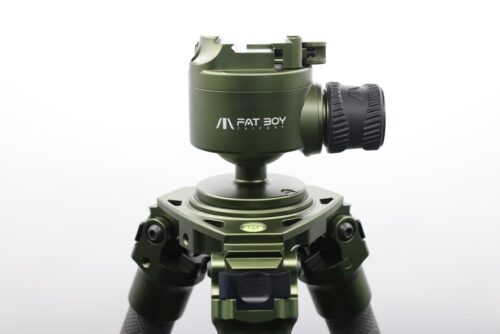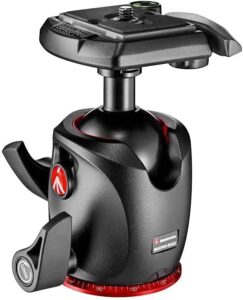Looking for the best tripod head? Here’s a comprehensive buying guide on the best tripod heads across different categories, ball, pan-tilt, geared, and fluid heads, so you can pick the right one depending on your needs.
Whether you’re a landscape photographer, wildlife shooter, or videographer, choosing the right tripod head is just as important as selecting the tripod itself. This tripod accessory is crucial for achieving stable and precise shots in photography and videography. Besides, it determines how easily you can pan, tilt, and adjust your camera for the perfect shot.
What Makes an Ideal Tripod Head?
Several features make an ideal tripod head. These features include:
- Stability and strength to support the camera securely without wobbling, even with heavy lenses
- Smooth movement that allows fluid panning and tilting for video or panoramic shots
- Adequate load capacity to handle the weight of your camera and accessories comfortably
- Versatility: The best tripod heads are compatible with different camera types and mounts
- Quick release system to enables fast mounting and removal of the camera
- Precision control that includes adjustable tension and locking mechanisms for exact positioning
- Solid build quality from high-quality materials resistant to wear and environmental conditions
- Compact & Lightweight. Last but not least, the tripod head should be compact, lightweight, and easy to carry without sacrificing strength
Best Tripod Heads
1. IFOOTAGE Komodo K7 Fluid Tripod Head
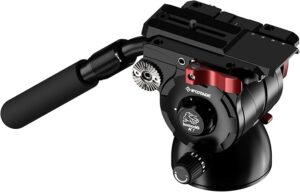
The IFOOTAGE Komodo K7 Fluid Tripod Head is the best tripod head. It is a robust and versatile tool designed for both professional videographers and photography enthusiasts seeking smooth and precise camera movements.
The selling point of this accessory is its fluid damping system. It allows for seamless pans and tilts, making it ideal for cinematic shots, interviews, and dynamic shooting scenarios. Furthermore, the ergonomic handle is adjustable and comfortable to grip, providing excellent control during long shoots.
Regarding construction, the head is crafted from high-quality aluminum alloy that gives it durability without compromising portability. Additionally, the K7 features a 75mm half-ball base that ensures stability on a wide variety of tripods, and the quick-release plate system allows for rapid mounting and dismounting of cameras.
Performance-wise, the Komodo K7 excels in delivering precise, fluid movements that enhance the overall production quality. The adjustable counterbalance system accommodates heavier camera setups, preventing jerky motions even when using professional cinema cameras.
Above all, its drag settings are intuitive and smooth, allowing users to fine-tune their movements for slow, sweeping shots or faster pans with equal precision.
Pros
- Smooth and precise fluid movements
- Adjustable counterbalance system for heavy cameras
- Durable yet lightweight aluminum alloy construction
- Compatible with most DSLR and mirrorless cameras
- Ergonomic controls for fine adjustments
Cons
-
Slight learning curve for counterbalance setup
2. Manfrotto XPRO Ball Head with 200PL Quick Release Plate
The Manfrotto XPRO Ball Head combines durability, versatility, and professional-grade performance, making it an excellent choice for anyone looking to elevate their video production quality.
Its robust construction, made from high-quality aluminum, ensures both durability and smooth performance, even under the weight of heavy DSLR cameras or medium-format setups. Furthermore, the ball head offers seamless 360-degree rotation and a wide range of tilt angles, making it effortless to frame shots from unique perspectives.
The intuitive friction control and independent pan lock allow for fine adjustments without disturbing the composition. On top of that, the ergonomic knob layout makes operation quick and precise, even in demanding shooting conditions.
In the field, the XPRO Ball Head delivers exceptional responsiveness and reliability, making it suitable for both studio and field work. Photographers will appreciate the smooth, fluid motion that facilitates panoramic shots, time-lapse sequences, and long exposures without unwanted camera drift.
To top it all off, this ball head features a compact yet sturdy design that pairs well with a variety of tripods without adding unnecessary bulk, and the safety stop feature prevents accidental over-rotation of the plate, ensuring equipment remains secure.
Pros
- Professional-grade solution for precision shooting
- Excellent lockability
- Solid build quality
- Versatile movement
- User-friendly controls
Cons
- Not ideal for ultra-lightweight setups
3. FatBoy Tripods Invert 50 Inverted Ball Head
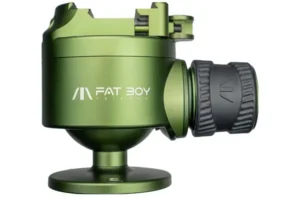
The FatBoy Tripods Invert 50 Inverted Ball Head is a versatile and robust piece of equipment designed for photographers and videographers who demand flexibility and stability.
Its inverted ball head design allows for low-angle and overhead shots without the usual hassle of cumbersome setups. As a result, it is perfect for macro photography, product shots, or creative perspectives.
Regarding build quality, the construction is solid, with high-quality materials that give the head a reassuring weight without being overly heavy. Furthermore, the adjustment knobs are smooth yet firm, allowing precise control over positioning, while the quick-release system simplifies mounting and dismounting your camera efficiently.
Performance-wise, the Invert 50 excels in stability and ease of use. It supports a wide range of camera sizes and weights, providing a balanced hold that minimizes wobble and vibration. On top of that, the ball head’s rotation and tilt mechanisms are fluid, enabling seamless transitions between angles while maintaining firm locks when needed.
Pros
- Smooth 360-degree rotation for versatile shooting angles
- Strong, stable build supports heavier cameras
- Intuitive and secure locking mechanisms
- Compact and portable design
- Ideal for low-angle and macro photography
Cons
- Slightly heavy for travel or lightweight setups
- Short learning curve for beginners
4. Arca Swiss Monoball Z1+ Single Pan Tripod Head
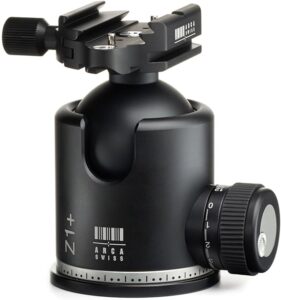
As one of the best tripod heads, the Arca Swiss Monoball Z1+ Single Pan Tripod Head stands out for its superior stability. It boasts an impressive 132.27 lbs (60kg) payload capacity to securely support professional-grade cameras and lenses and ensure sharp, stable images even with heavy equipment.
With precision control, you get accurate framing and smooth movements . Besides, the integrated friction control system allows for fine-tuned adjustments and effortless panning for capturing the perfect shot.
Another impressive feature of this ball head is its smooth operation. It features a single pan mechanism for seamless 360-degree rotation, ideal for panoramic photography and videography where it provides fluid and consistent performance.
Regarding weight, this tripod accessory weighs only 28.2 oz (800g). It offers exceptional portability without compromising on strength. Over and above that, it is equipped with a Quick Set Classic device and a 3/8″-16 thread base mount that makes it compatible with a wide range of tripods and Arca-Swiss style plates for versatile use.
Pros
- Lightweight and portable design
- Versatile use
- Superior stability
- Ease of adjustment
- Precision control
Cons
- Expensive for casual buyers
5. CAVIX 55mm Ball Head, CAVIX Low Profile Ball Head
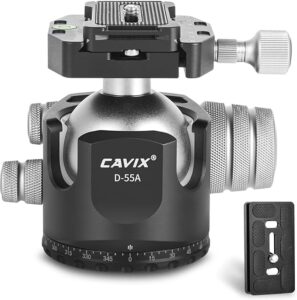
Here is the best budget tripod head. The CAVIX Low Profile Ball Head 55mm is a robust and versatile tripod head designed for photographers who demand precision and stability.
Its heavy-duty construction ensures it can support a wide range of camera setups, from DSLRs to mirrorless systems, without compromising on control. Furthermore, its 360-degree rotation capability allows for smooth panoramic shots, while the low-profile design keeps the center of gravity close to the tripod for enhanced stability.
The ball head’s locking mechanism is easy to operate, offering secure positioning for both quick adjustments and fine-tuned framing. Additionally, it boasts a sleek, compact form factor that makes it a convenient companion for photographers who travel frequently or need a reliable head for outdoor shoots.
Regarding performance, this ball head excels in both fluidity and durability. Its joint moves smoothly in all directions, allowing photographers to adjust their composition with minimal effort. Additionally, the 55mm diameter provides a solid base for heavy camera gear, reducing wobble and ensuring sharp, blur-free images even during long exposures or when using large telephoto lenses.
To complement everything else, the integrated quick-release plate speeds up mounting and dismounting, saving valuable time during shoots.
Pros
- Heavy-duty construction for long-term durability
- Smooth 360-degree rotation for panoramic shots
- Low-profile design enhances stability
- Precise tension control for flexible positioning
- Quick-release plate for fast camera mounting
Cons
-
Slightly heavier than other ultra-compact ball heads
6. EVUMO DX55 Ball Head
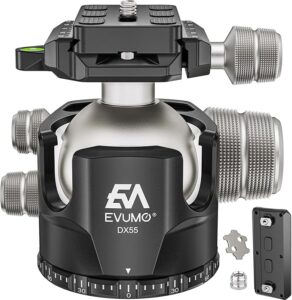
Next, we have the EVUMO DX55 Ball Head. It stands out as a robust and precision-engineered tripod accessory designed for photographers and videographers who demand stability and smooth movement.
The highlight of this tripod head is its build quality. Crafted from heavy-duty CNC-machined aluminum, it combines strength with a compact 55mm low-profile design, making it ideal for both travel and studio setups.
Furthermore, the low center of gravity enhances stability when supporting heavier cameras and lenses, while the smooth 360-degree panoramic rotation allows for precise framing and seamless panoramic shots.
What’s more, the locking mechanisms are responsive and secure, giving photographers confidence that their equipment will stay exactly where positioned without slipping or drifting. Additionally, the textured knobs provide excellent grip, allowing for fine adjustments without over-tightening or damaging the gear.
Other handy features this ball head boasts include a versatile quick-release system compatible with most Arca-Swiss plates, a fluid ball movement that allows for effortless tilting and panning, and an integrated bubble level to ensure perfect alignment for professional-grade shots.
Pros
- Heavy-duty CNC-machined aluminum construction
- Smooth 360-degree panoramic base
- Precise tension control for ball movement
- Quick-release clamp for easy camera mounting
- Built-in bubble level for accurate alignment
- Supports heavy camera and lens setups
Cons
-
The knobs take some getting used to for fine adjustments
7. NEEWER 2 Way Geared Tripod Head
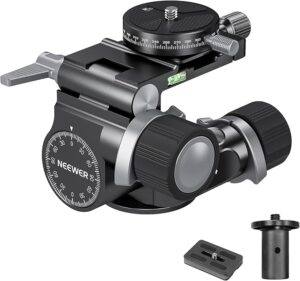
The NEEWER TH14 2 way geared tripod head is our last recommendation for the best tripod heads. IT allows for -90° to 90° tilt and 360° rotation, along with a 360° panoramic quick release plate for more flexible camera positioning.
This tripod head features damping friction control and a counterbalance system for seamless adjustments, with a φ25mm x 50mm short center column for efficient lifting and an extra quick release plate for spare use.
With two independent knobs for each mode, the pan tilt head allows easy adjustments from various angles, streamlining your workflow and saving you time. Furthermore, slide to attach the panoramic quick release plate to the tripod head, and achieve 360° horizontal rotation with precise scales for panoramic shots. Besides, an extra quick release plate is included for seamless and efficient device switching without replacing the plate
Regarding set up, the 1/4″ screw can mount a DSLR camera, mirrorless camera, cinema camera, telescope, and camcorder up to 13.2lb/6kg with rubber pads for scratch prevention. On top of that, the 3/8″ tripod socket connects the head to professional tripods, monopods, sliders, and camera dollies for stable image and video captures.
Construction-wise, this tripod accessory is made of premium aluminum alloy for long-term durability. It is robust and tough to withstand wear and tear. This makes it a great tool for macro/product photography, videography, studio work, panoramic photography, and architectural surveying.
Pros
- Smooth controls
- Stable and solid build
- Precise adjustments in all three axes
- Good value for money
Cons
- Orientation issues and slightly stiff knobs that require a break-in period
Key Considerations When Choosing a Tripod Head
Below are the key factors to consider when choosing the best tripod heads:
Load Capacity
The load capacity of a tripod head is the maximum weight it can safely support, including your camera, lens, and any additional accessories like a flash or microphone. Choosing a head with insufficient capacity can lead to instability, camera shake, or even accidents.
As a rule of thumb, select a head rated for at least 1.5 times the weight of your heaviest setup to ensure stability and longevity. For heavy telephoto lenses or professional DSLR rigs, geared or gimbal heads with higher load capacities are recommended.
Quick Release System
The best tripod heads feature quick release system that allows you to mount and remove your camera swiftly without needing to screw it in every time. This is essential for photographers who frequently switch between tripod and handheld shots. Common types include Arca-Swiss style plates or proprietary systems. Additionally, look for a head with a secure locking mechanism to prevent accidental slips, while ensuring it’s easy to operate under field conditions.
Smooth Operation
Next, smooth operation is critical, particularly for video and long-exposure photography. Fluid heads provide hydraulic damping to allow controlled pans and tilts, preventing jerky movements. Ball heads should have friction control knobs to adjust resistance for precise positioning. The smoother the movement, the easier it is to compose shots accurately, especially when tracking moving subjects or making incremental adjustments.
Ease of Use
The usability of the best tripod heads depend on the ergonomics of their controls. Look for well-placed knobs and handles that allow intuitive adjustments. Pan-and-tilt and geared heads offer precise control, but they can be slower to manipulate. On the other hand, ball or pistol grip heads offer rapid movement but less precision.
Durability
Tripod heads are subjected to varying environmental conditions and repeated stress. High-quality construction ensures that threads, knobs, and locks maintain their reliability over time. Opt for models made with materials like aluminum, magnesium alloy, or carbon fiber, which offer a balance of strength and weight. Avoid cheap plastic components that may wear out or break under heavy loads.
Compatibility
Furthermore, it is important to consider compatibility. This factor ensures that your tripod head fits both your tripod legs and camera system. Check the mounting thread size (usually 3/8” or 1/4”) and whether the head works with your tripod’s plate system. For photographers using multiple cameras or lenses, consider interchangeable plate systems that allow one plate to fit multiple devices.
Weight and Size
The head’s weight and size affect portability, stability, and overall handling. Lightweight heads are ideal for travel and hiking, but very small heads may struggle to stabilize heavy cameras. Conversely, large, heavy-duty heads provide stability but can be cumbersome for fieldwork. Balance your need for portability with the requirement for stability, choosing a head that suits both your gear and shooting environment.
How to Maintain a Tripod Head
1.Keep it clean: Wipe the head regularly with a soft, dry cloth to remove dust, dirt, and debris. Use a small brush or compressed air for hard-to-reach areas, especially around joints and screws.
2. Regularly tighten the screws and knobs: Check all adjustment knobs, screws, and quick-release mechanisms to ensure they are secure. Avoid over-tightening as it damage threads or reduce smooth movement.
3. Avoid overloading: Always respect the tripod head’s maximum weight capacity. Using a heavier camera or lens than recommended can strain the head, leading to instability or damage.
4. Lubricate moving parts: For fluid or gimbal heads, apply manufacturer-recommended lubricant occasionally to ensure smooth panning and tilting. Avoid over-lubricating the moving parts as it attracts dust and makes movements sticky.
5. Inspect for wear and tear: Check the tripod head periodically for cracks, worn-out washers, or loose joints. Replace damaged parts promptly to maintain stability and safety.
6. Proper and safe storage: Keep the tripod and head in a dry, cool place to prevent corrosion or rust. Use a protective bag when transporting to avoid scratches and impact damage.
Read Also
Best Tripod Heads FAQs
- Can I use any tripod head with any tripod?
Yes. Most tripod heads fit standard tripod mounts (usually 1/4″-20 or 3/8″-16 screws). Check compatibility between the head and tripod plate before buying for compatibility and to avoid instability.
- Which tripod head is best for photography?
Ball heads are the best for still photography due to their speed and flexibility. On the other hand, pan-and-tilt heads offer precise control for architectural shots.
- Which tripod head is best for video?
Fluid heads are the most ideal for smooth panning and tilting in video projects. Gimbal heads work best for heavy telephoto lenses in wildlife or sports videography.
- How do I know if a tripod head fits my camera?
Check the head’s load capacity and mounting screw size that is usually 1/4″-20 or 3/8″-16. Ensure it can safely support your camera and lens.
Conclusion
To wrap it, choosing the right tripod head can make a significant difference in your photography or videography experience. Whether you need the smooth motion of a fluid head for video, the precision of a ball head for still photography, or the versatility of a pan-tilt head, there’s an option to match every shooting style. Hopefully, we have steered you in the right direction.

